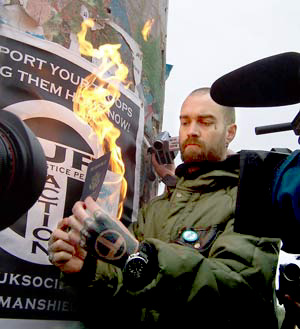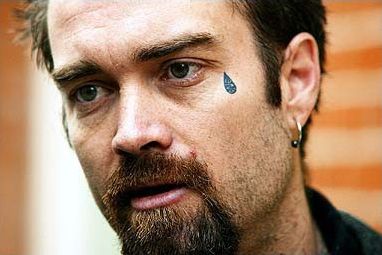BBC pro Israel massacre media deception attempt
on the MV Mavi Marmara which killed 9 humanitarian activists.
http://www.youtube.com/v/JI3_veUAcGE
http://www.youtube.com/v/VY3LvgCHjAg
http://www.youtube.com/v/MvgittWSbAA

She's peddling hasbara, but no one bought it. Ken O'Keefe is excellent.
Israel's public diplomacy efforts are called hasbara in Hebrew.
Hasbara, also spelt hasbarah, is a noun that literally means "explanation".
The term has been used by the State of Israel and by supporters of Israel
to describe their efforts to explain Israeli government policies, and
to promote Israel to the world at large. Detractors view hasbara
as a euphemism for propaganda.
lunches and free trips for influential journalists; seminars for Jewish
university students who over a week in a secluded country estate can be primed
to "defend" Israel on the campus; bombarding congressmen and -women with
invitations and visits; pamphlets and, most important, money for election
campaigns; directing (or, as the case requires, harassing) photographers and
writers of the current Intifada into producing certain images and not others;
lecture and concert tours by prominent Israelis; training commentators to make
frequent references to the Holocaust and Israel's predicament today; many
advertisements in the newspapers attacking Arabs and praising Israel; and on and
on.
Israel has eased its blockade on the Gaza Strip, not by as much as some would like, but the Middle East envoy and war criminal Tony Blair has said it is a "good start".
It follows the death of nine Turkish humanitarians murdered by Israeli soldiers when they attacked an aid flotilla as it tried to break the naval blockade on Gaza.

Kenneth O'Keefe was on that boat and he was involved in the violence. Sarah Montague asks him whether it was worth it.
You can watch this HARDtalk interview on Monday 28th June 2010 on the BBC News Channel at 0430 and 2330 BST. The programme was broadcast on BBC World News on Wednesday 23rd June at 0330, 0830, 1530 and 2030 GMT.
In December 2002 Kenneth O'Keefe, an ex-US Marine and Gulf War veteran who had formally renounced his US citizenship posted a call to action for large numbers of western citizens to migrate to Iraq and deploy themselves as "Human Shields". The action was ultimately named the TJP (Truth Justice Peace) Human Shield Action to Iraq. It was his position that protests and petitions had no chance of pre-venting the invasion and he reasoned that a large presence of western citizens, strategically placed in Iraq, at sites critical to the civilian population, was the only viable deterrent to the pre-planned war. The strategy of the action was based on the huge disparity between the way western lives and non-western lives are valued, thus he argued that thousands of Human Shields deployed to sites protected by the Fourth Geneva Convention would make the invasion politically untenable. O'Keefe was in the unique position of publicly acknowledging Saddam Hussein as a "violent dictator" and "mass-murderer" before he arrived in Saddam controlled Iraq, apparently he did this in an attempt to neutralize the inevitable accusations that the Human Shields were simply pawns of Saddam. Consequently he received no favor from the dictator, his influence within the action declined rapidly as he traveled to Iraq, and eventually he was deported days before the invasion. Before his deportation he repeatedly pointed to US and British support for Hussein during all of his worst crimes, ultimately he argued that it was the people of Iraq who would suffer most from war.
In January 2003 a group of dedicated anti-war activists joined O'Keefe in London and set out to carry out the plan as a new form of non-violent direct action. Acknowledging that traditional forms of protest were largely ineffective, on January 25, 2003 a group of 50 volunteers left London and headed for Baghdad with the intention of acting as human shields. The convoy travelled through Europe and Turkey by bus to pick up like-minded people along the way, totalling roughly 75 people. It has been estimated that 200 to 500 people eventually made their way into Iraq before the U.S. invasion in March.
Upon reaching Baghdad, a strategy was formed on the assumption that there would not be enough human shields to avert an invasion. This was to involve the voluntary deployment of activists to strategic locations throughout Baghdad, and possibly Basra, in an effort to avert the bombing of those locations. There was much internal debate about which locations were to be chosen.
Human shields greeted as they cross the border into Iraq, 15 February 2003
Eventually volunteers deployed to Al Daura Electrical Plant, Baghdad South Electrical Plant, 7 April Water Treatment Plant, Al Daura Water Treatment Plant, Tejio Food Silo, Al Daura Oil Refinery and Al Mamun Telecommunications Facility.
The need to work closely with the Iraqi government was not something many of shield volunteers felt comfortable with. Some felt that the list delivered by the officials compromised their autonomy. Others felt that they would rather be deployed in schools, hospitals, and orphanages. These shield volunteers left Iraq. The rest took up residence at the sites, a list of which was sent to the Joint Chiefs of Staff together with a request that they recognize their assertion that targeting these sites would be in violation of Article 54 Protocol Additional to the Geneva Convention. There was no response to the letters.
At its peak the total of shield volunteers in Baghdad numbered about 500, but the realization that the thousands needed to have a chance of stopping a blitz on Baghdad had not materialized, combined with the failure of the United Nations to forestall war, meant that bombing was imminent. Many of the shields chose to stay; many others chose to leave. Still others, like O'Keefe, were ordered out by the Iraqi government. One 21-year-old human shield, Tom Hurndall, left Baghdad for reasons of safety. He went to the Palestinian territories where he was shot by an Israeli soldier while working with the International Solidarity Movement.
None of the 80 shields who stayed in Baghdad throughout the war were killed or injured. None of the sites where they were residing were destroyed.
During their deployments a small group of volunteers led by Gordon Sloan of New Zealand took on the job of vetting sites to ensure they were not in close vicinity to military facilities. This was to be the cause of some conflict with their Iraqi host, Dr. Abdul Razak al-Hashimi, Saddam Hussein's spokesman during the first Gulf War, and head of the Friendship, Peace and Solidarity organisation which was hosting the activists, under the authority of the Baathist government.
With an invasion imminent, Hashimi became frustrated by Sloan's explorations, called a meeting, and asked the activists to deploy to sites or leave Iraq. Hashimi's meeting is said by some of the leading volunteers to have been a costly political mistake. It was the trigger of much anxiety among the volunteers and negative reporting in the media, including mis-reports that activists were being forced to deploy to military sites. It was also at this point that some of the British volunteers were to return to London along with the two double-decker red buses and their owner, which were originally meant to have left soon after arrival.
The paranoia that rose up around Hashimi's announcement and the reports that the buses were leaving Iraq slowed the influx of activists into Iraq, and caused some of those already there to leave Iraq, believing they had lost credibility through Hashimi's actions. The Iraqi authorities, on the other hand, saw Kenneth O'Keefe, Sloan, and other organisers as constantly challenging Hashimi's authority and being deliberately disruptive, and that some would-be shields were taking too long to deploy to sites. Five of the 'trouble makers' were then asked to leave the country.
Many activists stayed on, however, and continued to shield the chosen sites. It is claimed that eighty human shields stayed in the Baghdad area throughout the bombing campaign
 Earth's magnetic field:
Earth's magnetic field:


0 Comments:
Post a Comment
<< Home